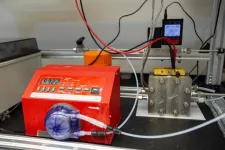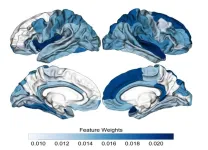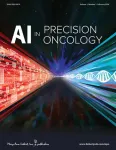(Press-News.org) Cosmic dust—like dust on Earth—comprises groupings of molecules that have condensed and stuck together in a grain. But the exact nature of dust creation in the universe has long been a mystery. Now, however, an international team of astronomers from China, the United States, Chile, the United Kingdom, Spain, etc., has made a significant discovery by identifying a previously unknown source of dust in the universe: a Type Ia supernova interacting with gas from its surroundings.
The study was published in Nature Astronomy on Feb. 9, and was led by Prof. WANG Lingzhi from the South America Center for Astronomy of the Chinese Academy of Sciences.
Supernovae have been known to play a role in dust formation, and to date, dust formation has only been seen in core-collapse supernovae—the explosion of massive stars. Since core-collapse supernovae do not occur in elliptical galaxies, the nature of dust creation in such galaxies has remained elusive. These galaxies are not organized into a spiral pattern like our Milky Way but are giant swarms of stars. This study shows that thermonuclear Type Ia supernovae, the explosion of white dwarf stars in binary systems with another star, may account for a significant amount of dust in these galaxies.
The researchers monitored a supernova, SN 2018evt, for over three years using space-based facilities like NASA’s Spitzer Space Telescope and NEOWISE missions, ground-based facilities like the Las Cumbres Observatory’s global network of telescopes, and other facilities in China, South America, and Australia. They found that the supernova was running into material previously cast off by one or both stars in the binary system before the white dwarf star exploded, and the supernova sent a shock wave into this pre-existing gas.
During more than a thousand days of monitoring the supernova, the researchers noticed that its light began to dim precipitously in the optical wavelengths that our eyes can see and then started glowing brighter in infrared light. This was a telltale sign that dust was being created in the circumstellar gas after it cooled following the supernova shock wave passing through it.
"The origins of cosmic dust have long been a mystery. This study marks the first detection of a significant and rapid dust formation process in the thermonuclear supernova interacting with circumstellar gas," said Prof. WANG, first author of the study.
The study estimated that a large amount of dust must have been created by this one supernova event—an amount equal to more than 1% of the Sun's mass. As the supernova cools, the amount of dust created should increase, perhaps tenfold. While these dust factories are not as numerous or efficient as core-collapse supernovae, there may be enough of these thermonuclear supernovae interacting with their surroundings to be a significant or even dominant source of dust in elliptical galaxies.
"This study offers insights into the contribution of thermonuclear supernovae to cosmic dust, and more such events may be expected to be found in the era of the James Webb Space Telescope (JWST)," said Prof. WANG Lifan from Texas A&M University, a co-first author of the study. The Webb telescope sees infrared light that is perfect for the detection of dust.
"The creation of dust is just gas getting cold enough to condense," said Prof. Andy Howell from Las Cumbres Observatory and the University of California Santa Barbara. Howell is the Principal Investigator of the Global Supernova Project whose data was used in the study. "One day that dust will condense into planetesimals and, ultimately, planets. This is creation starting anew in the wake of stellar death. It is exciting to understand another link in the circle of life and death in the universe."
END
Researchers discover cosmic dust storms from Type Ia supernova
2024-02-09
ELSE PRESS RELEASES FROM THIS DATE:
New fossil site of worldwide importance uncovered in southern France
2024-02-09
Nearly 400 exceptionally well-preserved fossils dating back 470 million years have been discovered in the south of France by two amateur paleontologists. This new fossil site of worldwide importance has been analyzed by scientists from the University of Lausanne, in collaboration with the CNRS and international teams. This discovery provides unprecedented information on the polar ecosystems of the Ordovician period.
Paleontology enthusiasts have unearthed one of the world's richest and most diverse fossil sites from the Lower Ordovician period (around 470 million ...
Global study: Wild megafauna shape ecosystem properties
2024-02-09
For millions of years, a variety of large herbivores, or megafauna, influenced terrestrial ecosystems. Among many others, these included elephants in Europe, giant wombats in Australia, and ground sloths in South America. However, these animals experienced a wave of extinctions coinciding with the worldwide expansion of humans, leading to dramatic but still not fully understood changes in ecosystems. Even the survivors of these extinctions strongly declined, and many are currently threatened with extinction.
While there are many case studies as well as theories about the effects of large animals, formal attempts to quantitatively synthesize their effects and establish ...
Towards A Better Way of Releasing Hydrogen Stored in Hydrogen Boride Sheets
2024-02-09
The looming threat of climate change has motivated scientists worldwide to look for cleaner alternatives to fossil fuels, and many believe hydrogen is our best bet. As an environmentally friendly energy resource, hydrogen (H2) can be used in vehicles and electric power plants without releasing carbon dioxide into the atmosphere.
However, storing and transporting H2 safely and efficiently remains a challenge. Compressed gaseous hydrogen poses a significant risk of explosion and leakage, whereas liquid hydrogen must be maintained at extremely low temperatures, ...
Language barriers could contribute to higher aggression in people with dementia
2024-02-09
Immigrants living with dementia were more likely to present with agitation and aggression compared with their non-immigrant counterparts, a new study by Edith Cowan University (ECU) in collaboration with The Dementia Centre, HammondCare, found.
Researchers from ECU’s Centre for Research in Aged Care and HammondCare’s The Dementia Centre noted that behaviours and psychological symptoms of dementia (BPSD), such as agitation and aggression, are common; however, its presentation may be influenced by the cultural background of the person.
A study investigated differences in clinical and demographics characteristics ...
Conversion process turns greenhouse gas into ethylene
2024-02-09
Engineers at the University of Cincinnati created a more efficient way of converting carbon dioxide into valuable products while simultaneously addressing climate change.
In his chemical engineering lab in UC’s College of Engineering and Applied Science, Associate Professor Jingjie Wu and his team found that a modified copper catalyst improves the electrochemical conversion of carbon dioxide into ethylene, the key ingredient in plastic and a myriad of other uses.
Ethylene has been called ...
Predicting psychosis before it occurs
2024-02-09
The onset of psychosis can be predicted before it occurs, using a machine-learning tool which can classify MRI brain scans into those who are healthy and those at risk of a psychotic episode. An international consortium including researchers from the University of Tokyo, used the classifier to compare scans from over 2,000 people from 21 global locations. About half of the participants had been identified as being clinically at high risk of developing psychosis. Using training data, the classifier was 85% accurate at differentiating between people ...
New research shows students' knowledge and perceptions of active learning declined during pandemic-era teaching
2024-02-09
Students’ knowledge and perceptions of active learning declined significantly during COVID-induced remote teaching and have not recovered to pre-pandemic levels, according to new research from Chapman University Assistant Professor Jeremy Hsu.
Hsu says the benefits of active learning – exercises like group projects, problem-solving and class discussions – are well documented, but he emphasizes that students’ understanding and perceptions of the practice can affect their level of engagement and investment. If students have limited exposure or are hesitant to participate in active learning practices, resistance could ...
Evaluating the performance of AI-based large language models in radiation oncology
2024-02-09
A new study evaluates an artificial intelligence (AI)-based algorithm for autocontouring prior to radiotherapy in head and neck cancer. Manual contouring to pinpoint the area of treatment requires significant time, and an AI algorithm to enable autocontouring has been introduced. The study is published in the peer-reviewed journal AI in Precision Oncology. Click here to read the article now.
Nikhil Thaker, from Capital Health and Bayta Systems, and coauthors, evaluated the performance of various LLMs, including OpenAI’s GPT-3.5-turbo, GPT-4, GPT-4-turbo, ...
Sandia awarded for outstanding work in technology transfer
2024-02-09
ALBUQUERQUE, N.M. — One of Sandia National Laboratories’ core missions is to help the world through innovation.
However, transferring some of that innovation from the Labs to industry isn’t always an easy process.
Through hard work and ingenuity, some Sandia employees are excelling at moving technology to market, a feat that is now being honored by the Federal Laboratory Consortium. The consortium, composed of more than 300 members nationwide, provides a forum to develop strategies and opportunities for linking laboratory technologies and expertise in the marketplace.
Regional Technology Transfer Award: Disinfectant ...
Evaluating AI-based nodal contouring in head and neck cancer
2024-02-09
A new study evaluates an artificial intelligence (AI)-based algorithm for autocontouring prior to radiotherapy in head and neck cancer. Manual contouring to pinpoint the area of treatment requires significant time, and an AI algorithm to enable autocontouring has been introduced. The study is published in the peer-reviewed journal AI in Precision Oncology. Click here to read the article now.
Sushil Beriwal, from Allegheny Health Network, and Varian, and coauthors, analyzed 108 patients ...







